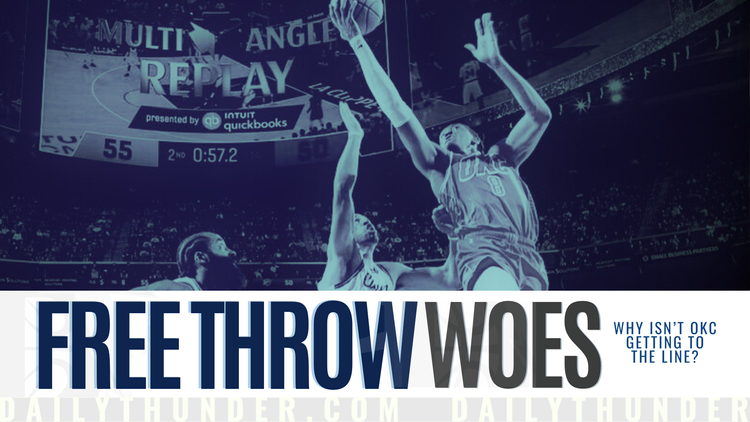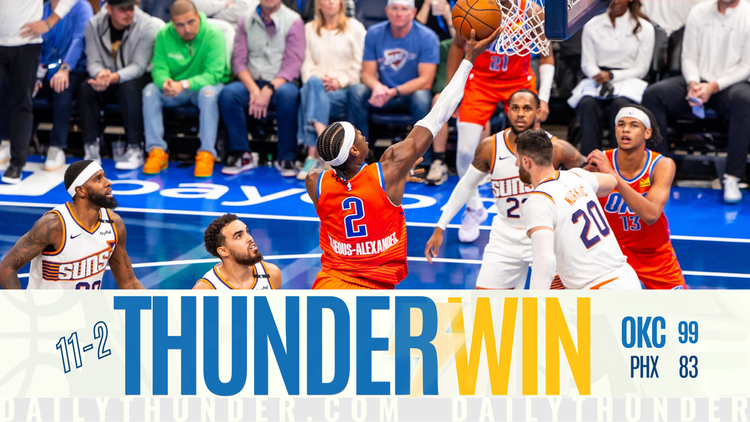Above the Noise: The Thunder’s Big Future

The big man position hasn’t gone away. It’s just changing.
The Thunder are now eyeing the future. And with the eventual roster overturn, questions surrounding the team’s eventual reconstruction are surfacing. Being a small-market team, rebuilding through the draft, or making trades, remain the only ways of keeping talent on the roster long term.
With the team and NBA changing, one thing that Sam Presti should embrace is the dynamic shift for the big man in today’s game.
For the past half-decade, the rhetoric around the NBA has resulted in the devout belief in the eventual extinction of the big man from basketball. You had teams going small, and then you had Houston going super-small. They elected to play P.J. Tucker at the center spot after trading Clint Capela. Houston’s win streak, post-Capela, led many to put the nail in the proverbial coffin for the big man in today’s NBA.
Yet, in the playoffs, something changed.
The Thunder pushed the Rockets to a seven-game series while playing either Steven Adams or Nerlens Noel. It’s arguable that if former Thunder head coach Billy Donovan played Noel (a viable lob threat) for the last possession of the game, the Thunder end up in the second round.
Houston’s micro-ball lineup didn’t usher in a new age of playing the game. Instead, it solidified the underlying truth about small ball and NBA championships–only special teams can win that way.
It also solidified the future of the position in my mind, and the reality that big men in the NBA never went away. To win, you still need them on your team. And though what they bring to the table might look a little different, their purpose on the floor is roughly the same.
Big moves
With that in mind, context is needed, so let’s peruse the history of the NBA big man in the last decade so that we can understand where the position might head next.
It started with Miami going small, playing Chris Bosh at the five spot and moving LeBron James to the four. Bosh was a non-traditional big that added another dimension to the game once slotted at center. He could stretch the floor up to the three-point line. Bosh was mobile enough to operate well on hard hedges or switches. He didn’t give up rebounds on the defensive and offensive glass. And he managed to anchor the defense for those early dynastic Heat teams.
Bosh showed the early model for the big man headed into the 2010s. He provided a bit of everything on the floor, while also freeing up the court for LeBron to relentlessly attack the rim. His move to the center spot signified a changing of the guard in the NBA. It also helped the Heat win two championships in four years. One of those coming against the young Oklahoma City Thunder.
The NBA is a copycat league, and when the Heat won with a mobile big who could space the floor, everyone other contender seemed to go in that direction, slowly. The Spurs’ championship in 2014 served as a reminder that a traditional center could still be the focal point of a team’s offense. But their lack of recent success illuminates their need to embrace the new look NBA.
The next two dynastic teams of the decade, the Warriors and the Cavaliers, provide a more extreme example of small ball’s progress.
In 2015 the Warriors won the NBA finals over the injury maligned Cavs. The “death lineup” that pushed them over the edge featured Draymond Green at the five with Andre Iguodala, Harrison Barnes, Klay Thompson, and Steph Curry on the perimeter. All five guys on the floor could create and manufacture offense for themselves and others. However, the engine that made that team go was Green. He allowed the Warriors to go “small” without playing small. Green could still rebound and defend bigger wings and centers while also adding another offensive creator on the floor. He was their unicorn.
The Cavs, though playing Tristan Thompson extensive minutes in the postseason, often moved Kevin Love to the five when the fourth quarter rolled around. He played a floor spacer role, while still adding rebounding to Cleveland’s frontcourt. Next to LeBron, he didn’t have to defend with the same fervor as Green, but still represented an attempt to downsize while spacing the floor.
The 2017 and 2018 Warriors teams modeled what position-less basketball looked like, but in reality their big was still always one of Green or Kevin Durant. Those two, when playing center, allowed the Warriors the benefit of having a big on the floor while also possessing the offensive flexibility of having another creator on that end.
And lastly, the 2019 Raptors featured a lineup that featured one of Pascal Siakam, Marc Gasol, or Serge Ibaka playing the five at any given time. Each brought a level of outside shooting, offensive creation, or switch-ability to the floor. It’s what made those Toronto teams so cohesive and deadly in the half-court. They had shades and wrinkles they could throw at an opponent that couldn’t be done without those unique bigs.
Still big
The best teams in the league have always had great bigs. They never went away. What they do just look different now than in the early 2000s.
Both the Heat and Lakers find themselves in the 2020 NBA finals. Both have bigs that play huge minutes for their team.
For Miami, there’s Bam Adebayo, a 6’9” center that can pass, handle, get to the basket, and operate out of the pinch post. On defense, he can protect the rim, guard positions 2-5 on the floor, and switch out onto guards when needed. He is the Heat’s best and most versatile player on the floor, a far cry from the direction many thought the big man was going in today’s NBA.
When you look at the Lakers, they have Anthony Davis. He is one of the most talented players in the league today and offers Los Angeles mobility, outside shooting, shot creation, post offense, and floor spacing. He’s an All-NBA player and has been the motor to the Lakers engine all postseason.
Small ball is here, but it isn’t what people perceive it to be–getting rid of big men on the floor. Instead, small ball is marked by offensive creation from the big spot on the floor, while not giving up the defensive advantages of a big on the other end.
Should the Thunder stay big?
In the next five years of this rebuild, the Thunder need to target bigs that offer versatility over anything else. Great wing and guard play is important for constructing a championship team, but what gets teams over the hump is an extremely versatile big.
The Thunder never got over the playoff hump because they never had a big that could do a bit of everything. Yes, there was Ibaka, but he couldn’t pass on the level of some of the aforementioned big men. And on top of that, Donovan nor Scott Brooks played Durant at the five for extensive minutes.
Adams has been an enforcer, but he lacks the athletic skill to keep up with the versatility of today’s NBA center. He also rarely ever punishes a team for going “small” against him.
So, step one of the anticipated rebuild should include securing a big man who can do a little bit of everything. And if the next decade of Thunder basketball is meant to contend for a championship, finding a Swiss Army knife of a big man has to be the first puzzle piece.
The center position in today’s league never went away, but changed under our noses. It’s time for the Thunder to modernize their five spot.





